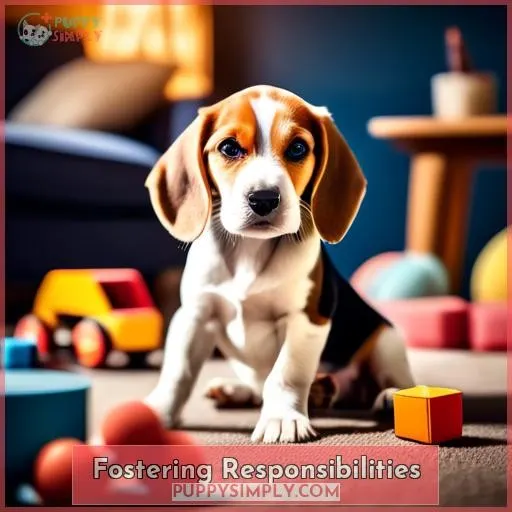This site is supported by our readers. We may earn a commission, at no cost to you, if you purchase through links.

While your instinct may be to scoop it up, beagles have unique care needs.
Before adopting one from a rescue, you’ll have to:
- Prepare your home
- Commit to training
- Understand the breed’s exercise and social requirements
But the loyalty of these affectionate pups makes the effort worthwhile.
Table Of Contents
- Key Takeaways
- Understanding Beagle Needs
- Beagle Rescue Missions
- The Adoption Process
- Preparing for a Beagle
- Fostering Responsibilities
- Special Considerations for Puppies
- Supporting Beagle Rescues
- Frequently Asked Questions (FAQs)
- How can I ensure a beagle from a rescue will get along with my existing pets?
- What are the common health issues to be aware of when adopting a rescued beagle?
- Can beagles adapt to apartment living, and what special considerations should I take?
- How do I manage a beagle’s strong scent-driven behavior, especially if I have a small yard or live in an urban area?
- What are the best strategies for integrating a rescue beagle into a household with young children?
- Conclusion
Key Takeaways
- Foster volunteers play a crucial role in socializing, providing medical treatment for, and preparing rescued beagles for adoption through a foster-based care network.
- Patience and open communication throughout the thorough adoption screening and matching process help ensure each beagle gets matched to a suitable forever home.
- Preparing for a rescued beagle requires establishing a safe and consistent home routine that meets the beagle’s daily exercise, training, and socialization needs.
- Raising a rescued beagle puppy demands extra effort on crate training, housebreaking, early obedience classes, and providing consistency to help the pup grow into a well-adjusted dog.
Understanding Beagle Needs
As you prepare for a beagle adoption, it’s crucial to comprehend three main areas of care to provide your new dog:
- Sufficient exercise paired with a healthy diet.
- Opportunities for social interaction.
- Solutions for addressing any training challenges unique to the breed.
Exercise and Diet
When bringing a beagle into your home, you’ll need to properly understand their exercise and dietary requirements for healthy development.
Beagles need daily outdoor walks and playtimes for physical health.
Plus, they require a nutritionally balanced diet that meets their high energy demands.
Establishing routines for sufficient activity and the right portions of quality dog food supports their wellbeing.
Social Interaction
One thing you’ll need to provide your rescued beagle is plenty of opportunities for social interaction to meet their innate pack mentality.
- Canine companionship
- Socialization techniques
- Playtime activities
- Behavioral cues
- Introducing strangers
Training Challenges
You’ll need patience when training a beagle because their strong sense of smell and wandering instincts can make it difficult for them to focus.
Challenge: Strong sense of smell
Strategy: Use high-value treats to keep attention
Challenge: Wandering instincts
Strategy: Practice recall frequently in safe areas
Challenge: Distractibility
Strategy: Keep training sessions short and engaging
Challenge: Stubbornness
Strategy: Use positive reinforcement, not punishment
Beagle Rescue Missions
When bringing a rescued beagle into your home, it’s crucial to understand where they’re coming from.
Beagle rescue organizations engage in missions to remove dogs from harmful breeding facilities and rehabilitate them through a foster-based care system before finding permanent homes.
Preparing for a rescued beagle means appreciating their background and committed path to rehabilitation from rescue all the way to your adoption.
Rescue and Rehabilitation
As you’re supporting these beagle rescue missions, you’ll witness firsthand the incredible care and rehabilitation foster volunteers provide these beagles.
These volunteers dedicate endless time and compassion to:
- Socializing the beagles
- Providing medical treatment
- Training and preparing the beagles for adoption
Their selfless efforts are vital for the rescue’s success.
The community’s involvement through donations and supplies fuels the volunteers’ capacity to rehabilitate countless beagles.
Foster-Based Care
The rescue utilizes a foster home network, so you’re directly involved in rehabilitating and preparing the beagles for adoption.
As a foster guardian, you provide transitional care and temporary guardianship, actively participating in the dogs’ rehabilitation and welfare.
This foster engagement allows you to directly impact canine rescue through hands-on animal fosterism, readying the pups for their forever homes.
The Adoption Process
The adoption process begins by submitting an application for review and approval.
Our experienced adoption coordinators carefully match each rescued beagle to an approved adopter and home environment.
Once the match is made, meet-and-greet visits with the foster family follow to ensure a smooth transition.
Application and Approval
You complete an adoption application to start the approval process for bringing home a rescue beagle.
Provide references and veterinary records.
Allow home visits to evaluate environment suitability.
Submit to background checks and criminal history screening.
The thorough screening process aims to ensure each beagle is matched with a forever home that meets their needs for exercise, companionship, training, and care.
With patience and open communication, you’ll soon embark on an exciting new chapter with your adopted beagle.
Matching Dogs to Homes
Once you’ve been approved, beagle rescue groups will match prospective adopters and available dogs according to their respective needs and preferences for the best fit.
Rescues thoroughly assess each applicant’s lifestyle, home suitability, family dynamics, and desired behavioral traits when matching dogs.
Careful compatibility evaluations help ensure the happiest outcomes for every adoptee and family.
With proper lifestyle evaluations and home suitability assessments, rescues can find the ideal behavioral match for each beagle’s unique personality and energy level.
Preparing for a Beagle
Before bringing home your new beagle companion, it’s crucial to prepare your home for their arrival and understand their care needs.
Make your house safe by removing hazards.
Establish a routine that meets their daily requirements.
Taking these steps will ease the initial transition and set you both up for success.
Home Safety
Before bringing your beagle home:
- Scout your house to identify and address any hazards.
- Pet-proof electrical cords.
- Secure toxic items.
- Latch unstable furniture to prevent accidents.
Establish:
- Emergency protocols.
- Safe interactions between children and pets.
Implement:
- Security measures on doors and fences to avoid escapes.
Your preparation creates a safe homecoming for a rescued beagle.
Routine Establishment
After securing your home for safety, you’ll want to establish a routine for your rescued beagle.
Build consistent routines around feeding, walking, playing, and training to help create order in your beagle’s world.
Setting predictable patterns for daily activities provides your dog comfort through structure, easing their adjustment to a new environment.
Maintaining regular habits and creating daily structure supports rescued beagles as they rebuild trust.
Fostering Responsibilities
As a foster parent, you’ll need to:
- Provide a safe environment
- Meet the basic care needs of your beagle
Basic obedience training is also an important responsibility to help socialize your foster dog.
Work on skills like:
- House training
- Leash walking
- Simple commands
to set up good behaviors for adoption.
Providing a Safe Environment
As a foster, you’ll need to provide a safe environment for your beagle.
Once the rescued beagle enters your home, take precautions to puppy-proof the space and establish a routine.
Conduct a hazard assessment, securing hazards and establishing emergency protocols.
Set clear boundaries and use gates to limit access.
Make safety a priority as you welcome this new family member into your home.
Basic Obedience Training
You can start basic obedience training with your foster beagle using positive reinforcement techniques.
Focus on desired behaviors through treats, praise, or toys when they respond correctly.
Be patient and consistent in reinforcing good habits during daily activities.
Socialize the beagle to various environments and people to improve behavior.
Track their training progress and make adjustments as needed to address any behavioral challenges.
Understanding the beagle’s unique triggers will inform effective behavior modification strategies.
Special Considerations for Puppies
When adopting a puppy, you’ll need to start crate training and housebreaking right away.
Puppies require a major time commitment for training – be prepared to enroll them in obedience classes.
Raising a well-adjusted pup takes consistency, patience, and effort on your part.
Crate Training and Housebreaking
Sixth, you’ll need to start crate training and housebreaking the puppy right away, using positive reinforcement, routine, and patience.
Set a feeding schedule to predict when the puppy needs to go outdoors, then praise and reward successes.
Crate training provides a den-like safe space and helps establish a potty routine.
Stay consistent with taking the puppy out and using verbal cues so they learn to go potty on command.
Patience is key, as housebreaking takes time, but crate training and schedules will lead to better habits.
Commitment to Training Classes
Typically, you’ll need to commit to training classes for your beagle puppy.
This will reinforce good behaviors and set them up for success as adult dogs.
Ongoing commitment to positive reinforcement training and socialization support is crucial during puppyhood.
Be prepared to provide training consistency with repeated practice of desired behaviors.
Professional trainers can guide you on properly reinforcing behaviors as your puppy develops.
Supporting Beagle Rescues
You can provide crucial assistance to beagle rescues in your community.
Donating your time as a volunteer or giving monetary support are impactful ways to aid rescue efforts.
Engaging with your local community builds essential awareness and engagement in beagle rescue missions.
Donations and Volunteering
As you’ve seen, rescue groups rely on the community for donations and volunteers. These are crucial for rescuing and rehabilitating beagles in need. The organizations depend on your contributions and assistance to continue their missions.
Fundraising events to generate financial support.
Outreach campaigns to increase awareness.
Volunteer training to expand capacity.
Your engagement fuels the rescue efforts. Consider hosting supply drives, participating in events, spreading the word, or directly supporting care expenses.
Together we can improve outcomes for beagles needing help.
Community Engagement
When you volunteer at adoption events or spread awareness on social media, you help build crucial community support for beagle rescue efforts.
Attending fundraising events, sharing sponsor opportunities online, and spearheading local outreach builds goodwill while securing essential funds for care, facilities, and future rescue missions.
As a pillar of support, engaged communities enable rescues to continue their life-changing work.
Frequently Asked Questions (FAQs)
How can I ensure a beagle from a rescue will get along with my existing pets?
Ensure your existing pets are up to date on vaccines.
Gradually introduce them to the beagle in a neutral area like a park.
Take them on walks together, praise calm interactions, and give them space if needed.
With patience, most dogs become fast friends.
What are the common health issues to be aware of when adopting a rescued beagle?
When adopting a rescued beagle, be aware of potential health issues:
- Heartworm
- Ear infections
- Hip dysplasia
- Eye problems
- Dental disease
Careful screening by the rescue organization helps identify pre-existing conditions needing treatment or long-term management.
Loving patience, proper care, and nutrition support their recovery.
Can beagles adapt to apartment living, and what special considerations should I take?
Adapting aplomb, apartments allure active beagles if allotted adequate ambling and amusing antics.
Consider canine companions craving continual comradery, so ensure enough energy exertion and engagement exists daily.
How do I manage a beagle’s strong scent-driven behavior, especially if I have a small yard or live in an urban area?
Stay committed to providing mental and physical stimulation through training, toys, games, and walks on a long line or in enclosed areas.
Be patient and consistent while redirecting destructive behaviors towards appropriate outlets.
Seek professional advice if struggling with containment or behavior issues.
What are the best strategies for integrating a rescue beagle into a household with young children?
Initially, keep interactions brief and highly supervised. Be patient, allowing gradual acclimation as the beagle bonds.
Lovingly help children understand rescue dogs’ skittishness, building compassion.
Reward gentle care with praise and treats, cementing nurturing habits for life.
Conclusion
Have you considered opening your heart and home to a beagle in need?
With proper preparation and commitment, you can provide a loving forever home to a rescued pup.
The rewards of beagle companionship make the initial effort worthwhile.
By supporting rescues through donations or fostering, you help give these sweet dogs a second chance while gaining a loyal friend.
When you welcome a rescue beagle into your life, you’ll soon discover the joy of this breed’s affectionate and amusing antics.













